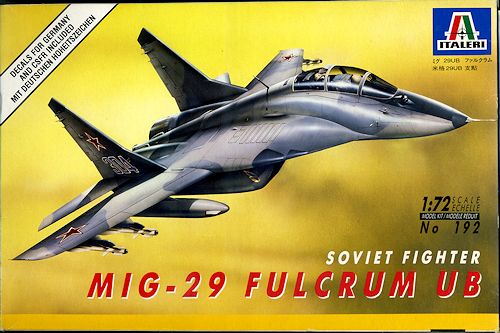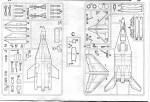
| KIT #: | 192 |
| PRICE: | I paid $5.00 (Current SRP is $23.00) |
| DECALS: | Three options |
| REVIEWER: | Scott Van Aken |
| NOTES: | Re |

| HISTORY |
The history of the MiG-29, like that of the larger Sukhoi Su-27 'Flanker', started in 1969 when the Soviet Union learned of the U.S. Air Force’s 'FX' program, which resulted in the F-15 Eagle. The Soviet leadership soon realized that the new American fighter would represent a serious technological advantage over all existing Soviet fighters. The MiG-21 'Fishbed' was agile by the standards of its day, but had deficiencies in range, armament, and growth potential. The MiG-23 'Flogger', developed to match the F-4 Phantom II, was fast and had more space for fuel and equipment, but lacked in maneuverability and dogfighting ability. What was needed was a better-balanced fighter with both good agility and sophisticated systems. In response, the Soviet General Staff issued a requirement for a Perspektivnyi Frontovoi Istrebitel (PFI, roughly "Advanced Frontline Fighter", directly "Perspective Forward Fighter"). Specifications were extremely ambitious, calling for long range, good short-field performance (including the ability to use austere runways), excellent agility, Mach 2+ speed, and heavy armament. The aerodynamic design for the new aircraft was largely carried out by TsAGI, the Russian aerodynamics institute, in collaboration with the Sukhoi design bureau.
However, in 1971 the Soviets determined that the PFI aircraft would be too expensive to procure in the quantities needed, and divided the requirement into the TPFI (Tyazholyi Perspektivnyi Frontovoi Istrebitel, "Heavy Advanced Tactical Fighter") and the LPFI (Legkiy Perspektivnyi Frontovoi Istrebitel, "Lightweight Advanced Tactical Fighter") programs, the latter paralleling the contemporary USAF decision that led to the "Lightweight Fighter" program and the F-16 Fighting Falcon and YF-17 Cobra. The heavy fighter remained with Sukhoi, resulting in the Su-27 'Flanker', while the lightweight fighter went to Mikoyan. Detailed design work on the resultant Product 9, designated MiG-29A, began in 1974, with the first flight taking place on October 6, 1977. The pre-production aircraft was first spotted by United States reconnaissance satellites in November of that year; it was dubbed Ram-L because it was observed at the Zhukovsky flight test center near the town of Ramenskoye. Early Western speculations suggested that the Ram-L was very similar in appearance to the YF-17 Cobra and powered by afterburning Tumansky R-25 turbojets.
Despite program delays caused by the loss of two prototypes in engine-related accidents, the MiG-29B production version entered service in August 1983 at the Kubinka air base. State acceptance trials where completed in 1984, and deliveries began the same year to the Soviet Frontal Aviation. The workload split between TPFI and PFI became more apparent as the MiG-29 filtered into front-line service with the VVS in the mid-1980s. While the heavy, long range Su-27 was tasked with the more exotic and dangerous role of deep air-to-air sweeps of NATO high-value assets, the smaller MiG-29 directly replaced the MiG-23 in the frontal aviation role. The Fulcrum was positioned relatively close to the front lines, tasked with providing local air superiority to advancing Soviet motorized army units. Rugged landing gear and protective intake grates meant the MiG-29 could operate from the damaged or under-prepared airstrips Soviet war planners expected to encounter during a rapid armored advance. The Fulcrum was also tasked with escort duties for local strike and interdiction air packages, protecting vulnerable ground attack aircraft from NATO fighters such as the F-15 and F-16. Frontal aviation MiG-29s would ensure Soviet ground forces could operate under a safe air umbrella, moving forward with the troops as they advanced.
In the West, the new fighter was given the NATO reporting name "Fulcrum-A" because the pre-production MiG-29A, which should have logically received this designation, remained unknown in the West at that time. The MiG-29B was widely exported in downgraded versions known as MiG-29B 9-12A and MiG-29B 9-12B (for Warsaw Pact and non-Warsaw Pact nations, respectively), with less capable avionics and no capability for delivering nuclear weapons. Total production was about 840 aircraft. The MiG-29 was first publicly seen in the West during a visit to Finland in July 1986. Two were displayed at the Farnborough Air Show in Britain in September 1988. Western observers were impressed by its apparent capability and exceptional agility, but found fault with the excessive smoke generated by its Klimov powerplants.
MiG-29 export customers have included Algeria, Bangladesh, Bulgaria, Cuba, Czechoslovakia, Eritrea, East Germany, Hungary, India, Iran, Iraq, Malaysia, Myanmar, North Korea, Peru, Poland, Romania, Serbia, Slovakia, Syria, and Yemen. The ex-Soviet republics of Belarus, Kazakhstan, Moldova, Turkmenistan, Ukraine, and Uzbekistan were left with large numbers of aircraft after the disintegration of the Soviet Union; some remain in service, others were mothballed or — like the 34 aircraft originally held by Moldova — have been sold abroad.
| THE KIT |
 To those who have built either the single seat version by Italeri or the ICM kit, the sprues will look quite familiar. There are two nicely done engraved light grey sprues with one in clear for the windscreen and canopy. I have been told that the Italeri kit was one of the many ESCI kits that Italeri has boxed over the years. Even if it is, it is quite nice.
To those who have built either the single seat version by Italeri or the ICM kit, the sprues will look quite familiar. There are two nicely done engraved light grey sprues with one in clear for the windscreen and canopy. I have been told that the Italeri kit was one of the many ESCI kits that Italeri has boxed over the years. Even if it is, it is quite nice.
As you might expect, there are some bits that are not the same as the single seat version and there are parts that are not used. The biggest change is, of course, the upper fuselage and the cockpit. The new upper fuselage piece has the tailplanes molded in place, something that I appreciate. It also shows the kits vintage as a newer mold kit would have separate tailplanes to up the parts count. The upper intake bypass doors are molded open so you have no choice but to build the kit in the 'ground operation' mode with the intake doors closed. This is a bit of a blessing in disguise as it will hide the inevitable seams that will be in the vertically split intake pieces.
Back at the cockpit, it has two generic bang seats, two control sticks and two instrument panels with raised detail. No cockpit decals on this one, which in this case is fine with me as my kit did not have decals. The landing gear and exhaust are properly complex looking, as are the exhaust sections. I guarantee that you'll have some fit issues with the upper and lower fuselage halves as I did with the single seat version. It might be a good idea to put some weight in the nose, just in case. There are a goodly number of weapons pylons; three on each wing. The inner one is for large fuel tanks while the outer ones hold short range missiles. The two seater did not have a big nose radar so the large long range missiles would not be appropriate. Most of the photos you'll find of the two seat version will have no weapons at all.
Instructions are well done and provide both FS 595 and Model Master paint references. As mentioned earlier, this kit had no decals, hence it being on the sales table. However, the instructions show three planes. One is the Soviet version shown on the box art that made the show circuit in North America during 1990. Another is with the former East Germany and a third is with the former Czechoslovakian Air Force, both of the latter from 1989. Usually Italeri decals work quite well. I have several aftermarket options for this plane that I will be using when I get around to building it.
| CONCLUSIONS |
Having previously built the Italeri MiG-29A and the ICM MiG-29C a bit over four years ago (has it been that long?), it was only natural that I'd want to do the two seat version to complete the collection. Actually, there is a MiG-29K that was developed for shipboard use, but I'm not sure if anyone kits that one. I am aware that this will not be a throw together build, but having built two similar kits, I'm pretty sure I can handle the fit issues it will present. In all, it is a pretty nice kit, though a bit dated and one that will undoubtedly not be kitted again soon.
| REFERENCES |
http://en.wikipedia.org/wiki/Mikoyan_MiG-29
2013
Thanks to me for the preview kit.
If you would like your product reviewed fairly and fairly quickly, please contact the editor or see other details in the